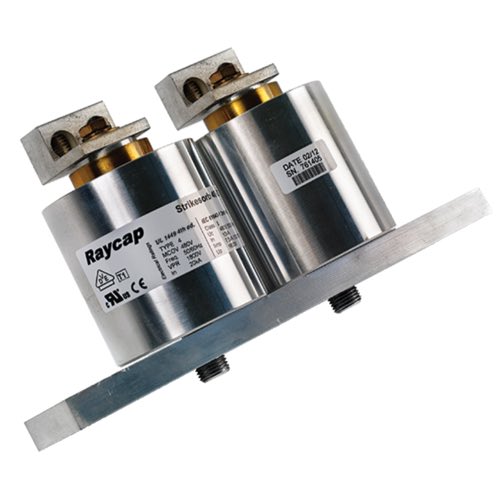Raycap AC Line Surge Protection

Raycap Strikesorb assemblies are designed to safeguard sensitive electronic equipment from the harmful effects of voltage surges and spikes. These assemblies are often used in a variety of applications, including telecommunications, renewable energy systems, and industrial settings.
The key feature of Strikesorb assemblies is their patented design that can effectively handle high surge currents without deteriorating over time. This leads to high reliability, which is a critical requirement for systems where downtime or equipment failure is not an option. Unlike traditional surge protection devices that might fail after a significant surge, Strikesorb assemblies are built to last and continue providing protection after multiple surge events.
Strikesorb assemblies typically come in different configurations to meet the unique requirements of various applications. They often include features like visual indicators or remote signaling capabilities to provide real-time status and alerts.
Surge Protection Basics
What causes power surges?
Lightning strikes are one of the most common causes of power surges and can affect an electrical system even if the strike occurs miles from the electrical source. Conductors buried underground can still transmit the energy of the strike to electrical equipment located indoors. Lightning rods and other grounding equipment can help, but do not completely eliminate the risk.
Switching equipment such as motors, transformers and other equipment can cause a sudden change in load, power loss and disconnection of circuit breakers. This sudden switching can cause overvoltage, leading to power surges. The closer the switching occurs to the electrical system, the more threat it will pose to the equipment.
Operations that a user performs can cause surges, but typically have a very short duration. Examples include: starting a motor, opening circuit breakers and welding equipment.
What is the best way to stop power surges?
By using transient surge suppressors, the problems associated with most transient surges can be eliminated. They provide protection by either blocking or shorting the voltage over its operating limit to ground, protecting circuits downstream of the suppressor. The best way to approach this is in tiers.
Tier 1 – The protection is closest to the incoming power source. This is the main protection for a particular location.
Tier 2 – This is in an area that will be protecting multiple devices that have branch protection. An electrical control panel would be an example of this type of application.
Tier 3 – Individual protection. In the case of an industrial control panel, this would be protection for each instrument entering the panel.

